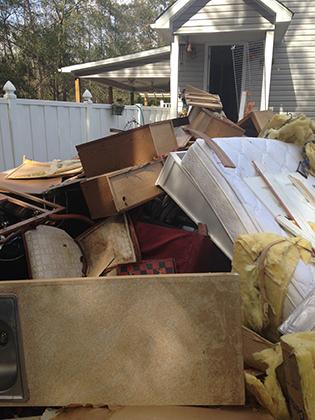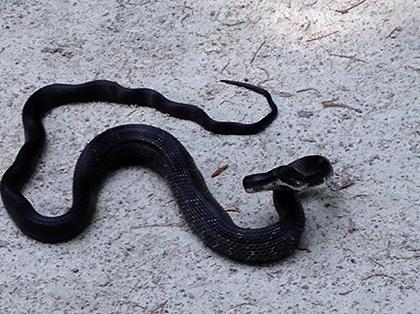Problems With Snakes
Like other residents in the path of a major storm, snakes become displaced and left homeless. As a result, they may seek shelter and food inside houses, storage sheds, barns, and other buildings. Damaged structures are more accessible to snakes and flooding may allow some snakes to swim or deposit them indoors. Displaced snakes may also be found under debris scattered by the storm or in debris piles created during the cleanup effort. It’s important to realize that both poisonous and non-poisonous snakes are beneficial to people because they help control rodents, which are also displaced by storms.
Tips for Working Around Snakes
Tips for working in areas where snakes may be found:
Outdoors
- Wear heavy work gloves and boots (at least 10 inches high), long pants or snake leggings (if available) when working in areas cluttered with debris. Avoid wearing shorts when working with debris.
- Watch where you place your hands and feet when removing or cleaning debris.
- Look carefully before you place your fingers in and under piles of debris that have been undisturbed at for any length of time.
- Never step over logs or other obstacles unless you can see the other side.
- Watch for snakes sunning on fallen trees, limbs, and other debris.
- If you encounter a snake, step back and allow the animal to proceed on its way. Snakes are not usually fast-moving animals, and you should be able to move out of their way. Snakes will often move out of the way, but watch where they go in case it's another debris pile or under a house, car, or other object.
Indoors
- If you find a snake in your house, don’t panic; try to confine the snake to a small area of the house.
- Non-poisonous snakes can be captured by pinning the snake down with a long stick or pole, preferably forked at one end, and then removed by scooping up with a flat-blade shovel.
- If you are uncomfortable about removing the snake yourself, try to get help from a neighbor or someone in the community who has experience handling snakes (local Animal Control staff may not be available due to other emergencies).
- As a last resort, you may need to kill a poisonous snake. Club it with a long stick, rod, or other tool. Never attempt to kill a poisonous snake with an object that brings you within the snake’s striking range (typically one-third to one-half of the snake’s total length). A pistol or rifle may seem to be a simple way to get rid of snake, but discharging a firearm in or around areas where people are cleaning up storm debris is dangerous, potentially lethal, and often illegal.
- All openings around the house a quarter-inch and larger should be sealed to exclude snakes and other unwanted wildlife. Check areas such as corners of doors and windows, crawlspace doors, gaps around water pipes, and electrical service entrances. To exclude snakes, seal holes in masonry foundations with mortar or expanding foam that hardens (such as Great Stuff). Holes in wooden buildings can be sealed with fine 1/8-inch mesh hardware cloth and/or sheet metal.
- Remove debris from around the house as soon as possible. Such clutter attracts rodents, lizards, and insects on which many snakes feed and also provides shelter for the snakes. Vegetation along the foundation should be kept closely mowed.
- There are no pesticides that can be used legally to kill snakes. Repellents and traps work with limited success.
If You Are Bitten by a Snake
If you are bitten by a poisonous snake, don’t try to treat the bite yourself. Go to the nearest hospital (or physician) or contact local emergency medical services about obtaining immediate treatment. Try to make a mental note of the appearance of the snake for identification and treatment purposes. Some non-poisonous snakes can be mistaken for copperheads and cottonmouths. Inexpensive snake-bite kits without antivenom are more harmful than helpful, and they should be avoided. Doctors no longer recommend these kits because of infection, tissue damage from cutting, and the risk of getting venom in a cut in your mouth. Anti-venom and antibiotic treatments are important to reduce the effect of the venom and the possibility of developing an infection.
Learn to identify non-poisonous and poisonous snakes. Information on snake identification can be obtained from your local N.C. Cooperative Extension center or from your state’s wildlife department.
For More Information
For more information on disaster preparedness and recovery visit the NC Disaster Information Center.
Original publication adapted by Pete Bromley, Extension Wildlife Specialist (Ret.), NC State University, from Alabama Cooperative Extension Service information.
Publication date: July 12, 2023
Revised: July 12, 2023
N.C. Cooperative Extension prohibits discrimination and harassment regardless of age, color, disability, family and marital status, gender identity, national origin, political beliefs, race, religion, sex (including pregnancy), sexual orientation and veteran status.




